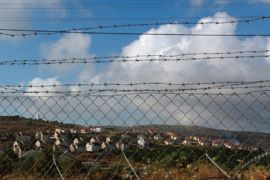Israel’s illegal settlements
A background to the building of Jewish settlements in the occupied Palestinian territories.

|
|
|
Israel says that its separation barrier is to protect settlements, but it also eats into Palestinian land |
Almost 40 years after Israel began its programme to install Jewish communities in the Palestinian territory it occupied, the expansion of settlements in the West Bank continues.
The issue remains one of the biggest obstacles to a lasting peace between the two sides and their presence remains a serious problem for the Palestinians who live and work nearby.
Although they are illegal under international law, 31 settlement outposts were expanded during the summer conflict with Lebanon alone, according to the Israeli settlement monitoring group, Peace Now.
Many of the outposts have been established close to Palestinian population centres deep in the West Bank, joining existing settlements together and breaking the links between Palestinian communities.
“Thus, the settlers are trying to thwart the possibility of the existence of a contiguous Palestinian state on the West Bank,” the group says.
Land division
Settlement municipalities currently occupy 40 per cent of total West Bank land, but it not just the towns themselves that lie on Palestinian land.
Exclusively for the use of Israelis, a whole network of roads, known as bypass roads, has been built t
|
Facts and figures – 460,000 Jewish settlers living in West Bank and East Jerusalem – 121 settlements and 102 unauthorised outposts
– 60 per cent of West Bank under Israeli military control
– Separation barrier will leave 8.6 per cent of West Bank on “Israeli side” |
o link the settlements together.
And Israeli army bases that house soldiers to protect the settlers have also been built nearby.
Israel’s separation barrier, which it maintains is to protect it against Palestinian suicide attacks, also snakes around villages close to settlements, leaving about three-quarters of settlers on the “Israeli side” of the barrier.
Built on land stolen from Palestinians by the Israeli state, the settlements divert scarce resources, particularly water, and pollute Palestinian farmland.
Settlers, many of whom are armed, are also responsible for regular attacks on Palestinians, although they are rarely prosecuted by the Israeli authorities.
Peace Now documents 57 such instances during 2005 alone.
International law
The Fourth Geneva Convention prohibits the transfer of the population of an occupying power to the territories they occupy.
 |
| Ariel lies deep inside occupied Palestinian territory |
The Hague Regulations forbid an occupying power from making permanent changes to the area it controls.
In August 2005, Israel removed its settlers – and the soldiers that protected them – from Gaza.
Ehud Olmert, the Israeli prime minister, also planned to withdraw some small settlement outposts from the West Bank and unilaterally draw Israel’s borders, including the larger settlements and breaking previous peace agreements with Palestinians.
But that plan has been put on hold after his government was weakened by the Israeli military’s failure to defeat Hezbollah in the summer 2006 conflict.
The so-called roadmap peace plan of 2002 calls for a freeze on settlement building and the US has repeatedly called for an end to their construction.
But in 2004, George Bush, the American president, appeared to admit that some West Bank settlements would remain under Israeli control after any future peace agreements.
Religious zealots
Israel’s settlement building project began in 1967, soon after it occupied the West Bank and Gaza following the Six-Day war.
The programme was inspired by the Allon plan, a final settlement suggested by Yigal Allon, a former defence minister, that envisaged Jordan taking control of large Palestinian population centres in the West Bank while Israel controlled the rest.
The architects of the plan believed that the colonisation of the West Bank would allow Israel to secure its borders more effectively.
Twenty-one settlements had been built in the Jordan Valley by 1977, and construction intensified after the election of the Likud government.
 |
|
Settlement outposts continue to be built |
The settlements themselves can take many forms. In Maale Adumim, East Jerusalem, they resemble US-style suburban homes with their red roofs and green lawns.
Outposts such as Migron are little more than a few mobile homes on a rocky hilltop.
In the centre of Hebron, hardline settlers protected by the Israeli army have built their houses literally on top of Palestinian homes.
The settlers themselves move to the West Bank for a variety of reasons. Some believe that the land is part of a greater, biblical Israel – but for many the motive is financial.
Settlers recieve seven per cent off their income tax, according to a report by the Israeli newspaper, Haaretz.
And Israelis moving to the West Bank also recieve generous grants and loans to buy their homes, and companies recieve government aid to set up operations in the West Bank.
Opinions polls suggest that the Israeli public supports the government’s plans for the partial withdrawal of settlements.
Despite this, their expansion on Palestinian land continues, and tenders were issued to build 952 new settlement homes in the West Bank this year, Peace Now says.
While the Israeli government sanctions this construction, Palestinians will continue to suffer the effects of an illegal colonisation programme that the rest of the world seems unable – or unwilling – to halt.
